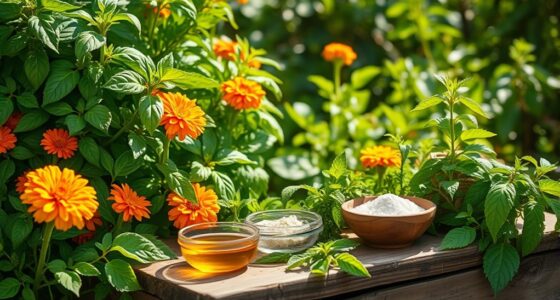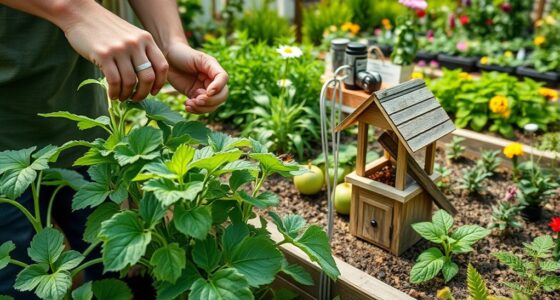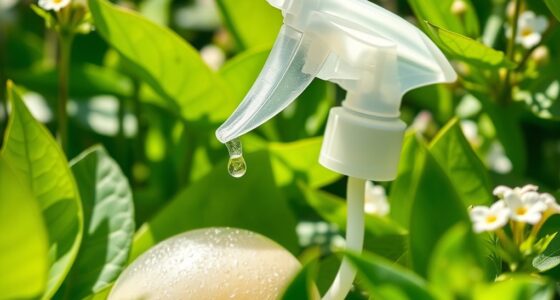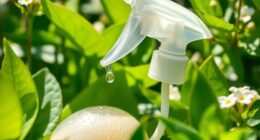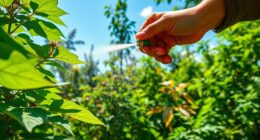To create a DIY natural insecticide, mix 1-2 tablespoons of pure, gentle soap like castile soap into a gallon of water. Shake well and test a small plant before full application. Spray thoroughly during early morning or late evening, ensuring all plant surfaces and pests are covered. Reapply every few days or after rain. Using proper soap formulations and regular treatments helps keep pests at bay without harming your plants—keep exploring to get even better at using soap sprays!
Key Takeaways
- Use pure, additive-free soaps like castile or gentle dish soap for effective, safe DIY insecticidal soap sprays.
- Dilute soap in water (1-2 tablespoons per gallon) and dissolve thoroughly before application.
- Test on a small plant area first and apply during early morning or late evening to prevent leaf burn.
- Cover all plant surfaces thoroughly and reapply every few days or after rain for ongoing pest control.
- Combine soap sprays with cultural, biological, and mechanical methods for integrated pest management.
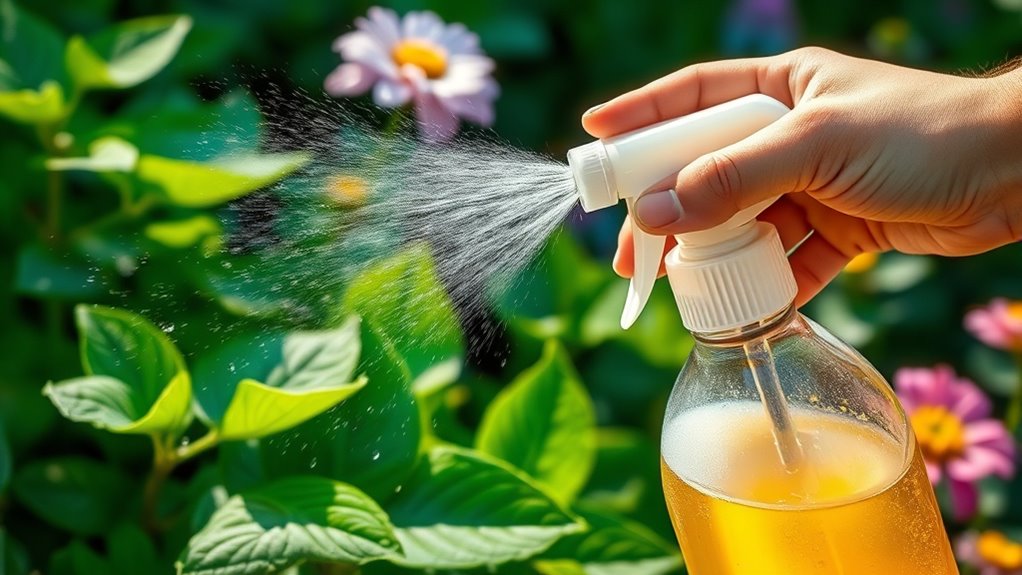
Soap sprays are an effective and eco-friendly way to control pests and diseases in your garden. They work by coating the pests with a thin film that suffocates or disrupts their cellular functions, making them a safe alternative to chemical pesticides. When you’re considering soap sprays, understanding the significance of soap formulation becomes vital. Not all soaps are suitable, as some contain additives or degreasers that can harm your plants. A simple, pure soap—like castile soap or a gentle dish soap without fragrances or dyes—is typically the best choice. Proper soap formulation ensures that your homemade spray remains effective against pests while being gentle on your plants and beneficial insects.
One key advantage of soap sprays is their ability to minimize pest resistance. Unlike chemical pesticides that pests can develop resistance to over time, soap sprays attack pests physically and chemically in a way that’s hard for them to adapt to. This means you can use soap sprays regularly without the worry of pests becoming immune. However, it’s essential to rotate your pest control methods and not rely solely on soap sprays to avoid potential resistance buildup. Applying the soap spray correctly—covering all plant surfaces thoroughly but avoiding excessive use—also helps maintain its efficacy and reduces the risk of pests developing resistance.
When preparing your soap spray, pay close attention to the soap formulation. Use a small amount of soap diluted with water, typically about one to two tablespoons of soap per gallon of water. Shake or stir well to ensure the soap dissolves completely. This concentration is usually effective at suffocating pests like aphids, spider mites, and whiteflies, without damaging your plants. Keep in mind that overly concentrated solutions can lead to leaf burn or stress, so it’s better to start with a weaker mixture and increase as needed. Also, test a small area of your plant first to see how it reacts before applying the full spray.
Consistency and timing are key when using soap sprays. Applying the spray in the early morning or late evening, when the sun isn’t at its peak, helps prevent leaf burn and allows the soap to stay on pests longer. Reapply every few days or after rain to keep pests at bay. Remember, soap sprays are most effective when used as part of an integrated pest management approach, combining cultural, biological, and mechanical controls. By paying attention to soap formulation and understanding pest resistance, you’ll maximize your success in maintaining a healthy, pest-free garden using natural, homemade soap sprays.
Frequently Asked Questions
Can Soap Sprays Harm Beneficial Insects Like Bees?
You’re wondering if soap sprays harm beneficial insects like bees. While soap spray safety is generally good when used correctly, there can be a beneficial insect impact if applied improperly or in high concentrations. To protect pollinators, avoid spraying during bloom times and target only affected plants. This way, you minimize harm while managing pests effectively, ensuring your garden stays healthy and safe for beneficial insects.
How Often Should I Reapply Soap Sprays for Effectiveness?
Imagine noticing aphids returning after a week; this highlights the importance of a proper soap spray schedule. Usually, you should reapply soap spray every 7 to 10 days, depending on pest severity. Consistent reapplication frequency helps maintain control without harming beneficial insects. Adjust your soap spray schedule based on pest activity, weather conditions, and plant response to guarantee effective, safe pest management while protecting your garden’s ecosystem.
Are Homemade Soap Sprays Safe for Edible Plants?
You wonder if homemade soap sprays are safe for edible plants. Generally, they are, but it’s vital to take into account plant safety and soap concentration. Use mild, biodegradable soap and dilute it properly to avoid harming your plants. Always test on a small area first. If you notice any damage, rinse thoroughly. Proper soap concentration helps protect your edible plants while effectively managing pests.
What Are the Signs of Soap Spray Overuse on Plants?
You might notice plant stress or leaf damage if you overuse soap sprays, which can seem coincidental but is quite common. Watch for yellowing, curling, or wilting leaves, indicating your plants are struggling. Excess soap can strip away natural waxes, causing leaf damage and making plants more vulnerable. Keep an eye on these signs, and always follow recommended application rates to prevent harm and keep your garden thriving.
Can Soap Sprays Be Used on Indoor Houseplants?
Yes, you can use soap sprays on indoor houseplants for pest control. They’re effective for indoor pest control and help with plant cleaning techniques by removing dust and pests safely. Just make sure you dilute the soap properly and test a small area first to avoid damage. Regular application can keep your houseplants healthy and pest-free, making them look vibrant and thriving inside your home.
Conclusion
Now that you know how to make your own soap spray, imagine the possibilities for your garden’s health. Will this simple solution be enough to keep pests at bay? Or will new challenges arise that test your gardening skills? Don’t forget, nature is full of surprises—stay alert and ready to adapt. With this DIY insecticide in your toolkit, you’re one step closer to a thriving, pest-free garden. Are you ready to see the results?


